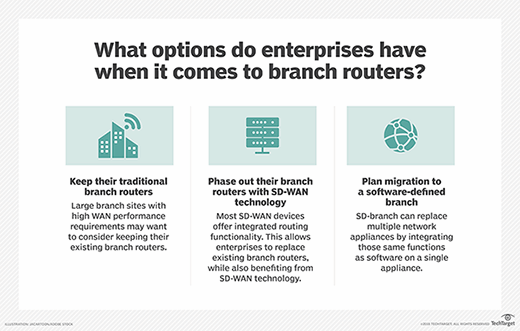
spainter_vfx - stock.adobe.com
7 key SD-branch trends to expect in 2020
New year, new developments. See what's new with SD-branch in 2020, including security advancements and how technologies such as Wi-Fi 6 and 5G will affect branch offices.
Remote branch connectivity will be a critical element of IT architectures for years to come. Organizations require high-quality, reliable and secure delivery of cloud- or data center-based applications, and organizations must network a wide variety of users and IoT devices in remote and often changing locations.
Software-defined branch, or SD-branch, technology offers significant benefits for deployment speed, ease of operations and cost. The year 2020 will see an increased number of suppliers that offer SD-branch services, as well as improvements in integration and management quality of existing products.
Advances in software networking and virtualization enable suppliers to package a wide range of network and security functions onto a unified platform. SD-branch simplifies network operations and consolidates WAN connectivity -- such as software-defined WAN (SD-WAN) and routing -- as well as network security, LAN and Wi-Fi, in a unified platform that's easy to deploy and manage. IT professionals can rapidly deploy SD-branch as a complete service.
SD-branch trends in 2020
In 2020, SD-branch will see several developments, ranging from vendors to architectures and capabilities. Here are seven key SD-branch trends we can expect this year.
SD-branch implementations. Many network and security vendors currently offer SD-branch services, including Hewlett Packard Enterprise's Aruba Networks, Cisco Meraki, Cradlepoint, Fortinet, Juniper Networks, Versa Networks, Netsurion and Riverbed, among others. In 2020, several other suppliers will likely introduce SD-branch services.
Distributed organizations will also increasingly deploy SD-branch for greenfield and branch network refresh projects in 2020. Doyle Research expects the SD-branch market to grow from several hundred million dollars in 2019 to several billion dollars by 2023.
Enhanced Wi-Fi capabilities. Wi-Fi will continue to be a critical technology for many remote branches -- especially those with customer-facing activities in retail, restaurants and retail banking. Wi-Fi functionality in SD-branch will need to support continued technology advancements, such as Wi-Fi 6.
Many customers support a multitude of Wi-Fi applications, such as point of sale, employee connectivity, security cameras, guest Wi-Fi and IoT applications. For these customers, Wi-Fi functionality must include strong network segmentation and quality of service (QoS) capabilities.

5G and 4G LTE. In most geographies, cellular wireless technology has advanced to become a significant part of branch connectivity services. At a minimum, many organizations will use 4G or 5G as a WAN backup service. Yet, as 4G and 5G data plans mature, business customers will increasingly use wireless as an integral part or as a primary WAN service. Other customers will use 5G as part of their IoT connectivity strategies.
Improved security. Network software and network security technologies continue to converge into more comprehensive offerings. Both will rely more and more on cloud-based intelligence. In 2020, SD-branch suppliers will expand their security offerings to include endpoint, zero-trust, cloud access security broker, and security information and event management functionality.
Administrators can set uniform security policies easily across Wi-Fi, LANs and WANs. In addition, SD-branch vendors will deepen the integration with leading network security suppliers.
LAN to WAN integration. Ultimately, SD-branch services should act as one network system and not a collection of functional elements. Suppliers have improved their abilities to provide QoS and security uniformly across Wi-Fi, Ethernet and SD-WAN elements. IT managers should set a policy once across LAN and WAN, as well as easily identify which element -- e.g., Wi-Fi or internet -- is responsible for application slowdowns.
Improved management, automation and orchestration. SD-branch should present a consistent unified platform for rapid deployment and centralized control of security policies, QoS, applications, users and devices. Many SD-branch services are in the initial stages of integrating management across various service elements, such as Ethernet, Wi-Fi, SD-WAN and security.
IT personnel need to provide high-quality application performance on an end-to-end basis and quickly identify and remediate application slowdowns. In 2020, suppliers will offer improved management, automation and orchestration capabilities with better end-to-end visibility and functional element integration -- e.g., LAN and WAN.
Branch in a box. In 2020, SD-branch services will expand beyond networking and network security to include edge computing, or mini data centers at the branch. Enterprise organizations need local compute and storage for a variety of application and compliance requirements, so organizations that deploy a wide array of IoT devices will increase demand for compute and storage at the branch.
Organizations should integrate edge computing capacity with LAN infrastructures. In addition, edge computing must easily connect to related IaaS cloud resources -- e.g., AWS and Microsoft Azure.
Recommendations for IT leaders
SD-branch technology is now widely deployed in several geographies and major vertical industries, including retail, financial services and manufacturing.
SD-branch provides significant benefits, including rapid deployment, reduced complexity and lower management costs. In 2020, suppliers will aim to improve SD-branch elements, such as Wi-Fi and 5G, offer better management integration and add edge computing capabilities. Also, 2020 will see a number of new suppliers enter the market, as well as various managed service offerings.
Enterprises should deploy SD-branch in greenfield locations and temporary sites and as an upgrade or replacement for smaller branch offices, stores and other remote locations. SD-branch technology will mature over the next two to three years and will likely become standard for branch networking and IT deployments.






